Career Development Plan for Xisco Training Institute
VerifiedAdded on 2022/11/29
|9
|2136
|187
Report
AI Summary
This report provides a comprehensive analysis of career development plans, focusing on the application of various theories within the context of the Xisco Training Institute. The report begins by introducing the importance of career development and then delves into three key theories: Holland's theory of vocational choice, Super's life-span, life-space theory, and Maslow's hierarchy of needs. Holland's theory is examined for its focus on matching personality traits with work environments, while Super's theory emphasizes the role of self-concept and life experiences in career development. Maslow's hierarchy is presented as a motivational framework, highlighting how individuals' needs influence their career choices. The report then rationalizes the selection of Super's model for the training institute, explaining its emphasis on self-concept realization. The implementation of the model is discussed, including how it can facilitate self-reflection and align with professional standards. Finally, the report provides an example of the Super Model's effectiveness through the example of Jeff Bezos, emphasizing the importance of self-enhancement and career planning.
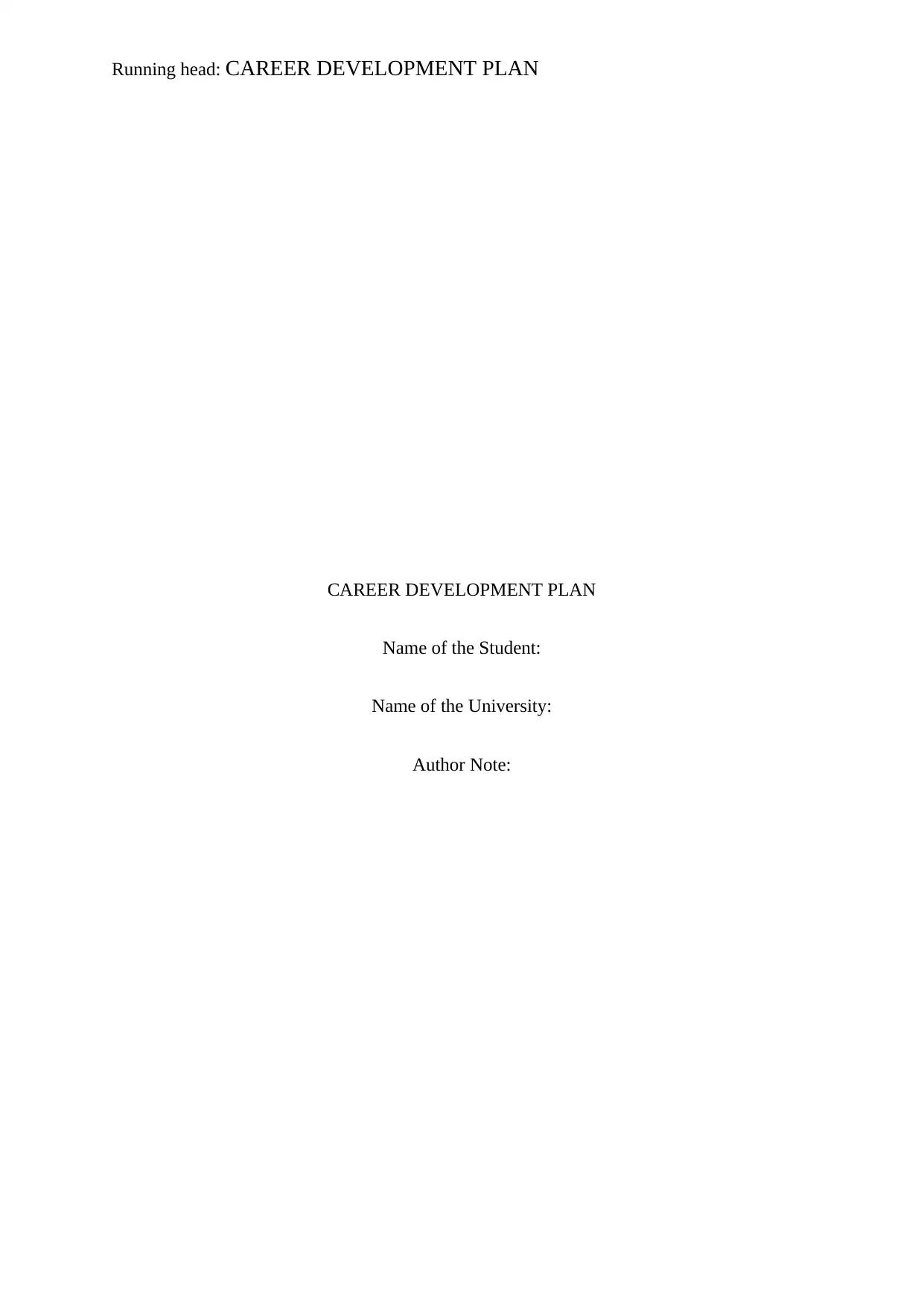
Running head: CAREER DEVELOPMENT PLAN
CAREER DEVELOPMENT PLAN
Name of the Student:
Name of the University:
Author Note:
CAREER DEVELOPMENT PLAN
Name of the Student:
Name of the University:
Author Note:
Paraphrase This Document
Need a fresh take? Get an instant paraphrase of this document with our AI Paraphraser
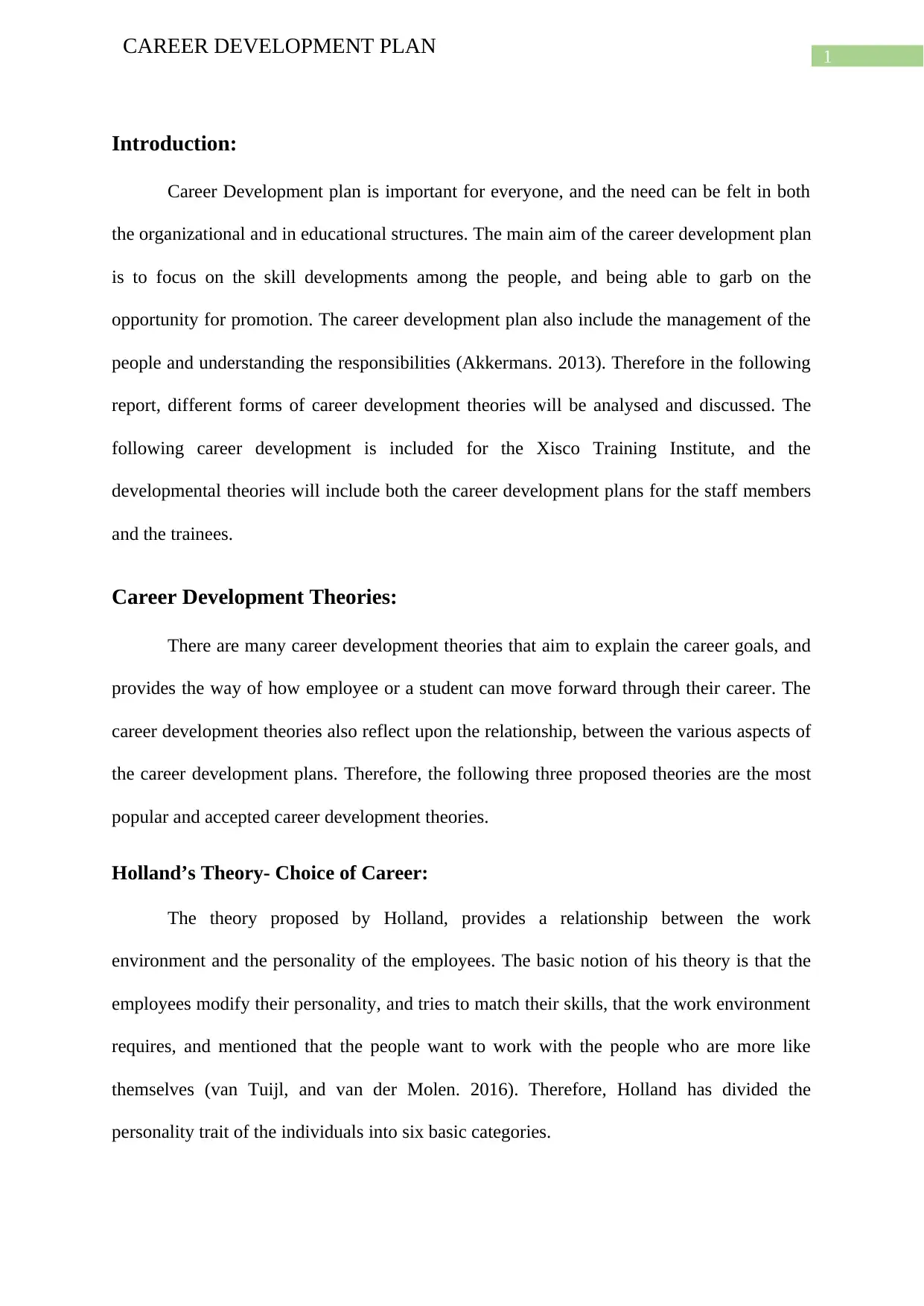
1
CAREER DEVELOPMENT PLAN
Introduction:
Career Development plan is important for everyone, and the need can be felt in both
the organizational and in educational structures. The main aim of the career development plan
is to focus on the skill developments among the people, and being able to garb on the
opportunity for promotion. The career development plan also include the management of the
people and understanding the responsibilities (Akkermans. 2013). Therefore in the following
report, different forms of career development theories will be analysed and discussed. The
following career development is included for the Xisco Training Institute, and the
developmental theories will include both the career development plans for the staff members
and the trainees.
Career Development Theories:
There are many career development theories that aim to explain the career goals, and
provides the way of how employee or a student can move forward through their career. The
career development theories also reflect upon the relationship, between the various aspects of
the career development plans. Therefore, the following three proposed theories are the most
popular and accepted career development theories.
Holland’s Theory- Choice of Career:
The theory proposed by Holland, provides a relationship between the work
environment and the personality of the employees. The basic notion of his theory is that the
employees modify their personality, and tries to match their skills, that the work environment
requires, and mentioned that the people want to work with the people who are more like
themselves (van Tuijl, and van der Molen. 2016). Therefore, Holland has divided the
personality trait of the individuals into six basic categories.
CAREER DEVELOPMENT PLAN
Introduction:
Career Development plan is important for everyone, and the need can be felt in both
the organizational and in educational structures. The main aim of the career development plan
is to focus on the skill developments among the people, and being able to garb on the
opportunity for promotion. The career development plan also include the management of the
people and understanding the responsibilities (Akkermans. 2013). Therefore in the following
report, different forms of career development theories will be analysed and discussed. The
following career development is included for the Xisco Training Institute, and the
developmental theories will include both the career development plans for the staff members
and the trainees.
Career Development Theories:
There are many career development theories that aim to explain the career goals, and
provides the way of how employee or a student can move forward through their career. The
career development theories also reflect upon the relationship, between the various aspects of
the career development plans. Therefore, the following three proposed theories are the most
popular and accepted career development theories.
Holland’s Theory- Choice of Career:
The theory proposed by Holland, provides a relationship between the work
environment and the personality of the employees. The basic notion of his theory is that the
employees modify their personality, and tries to match their skills, that the work environment
requires, and mentioned that the people want to work with the people who are more like
themselves (van Tuijl, and van der Molen. 2016). Therefore, Holland has divided the
personality trait of the individuals into six basic categories.
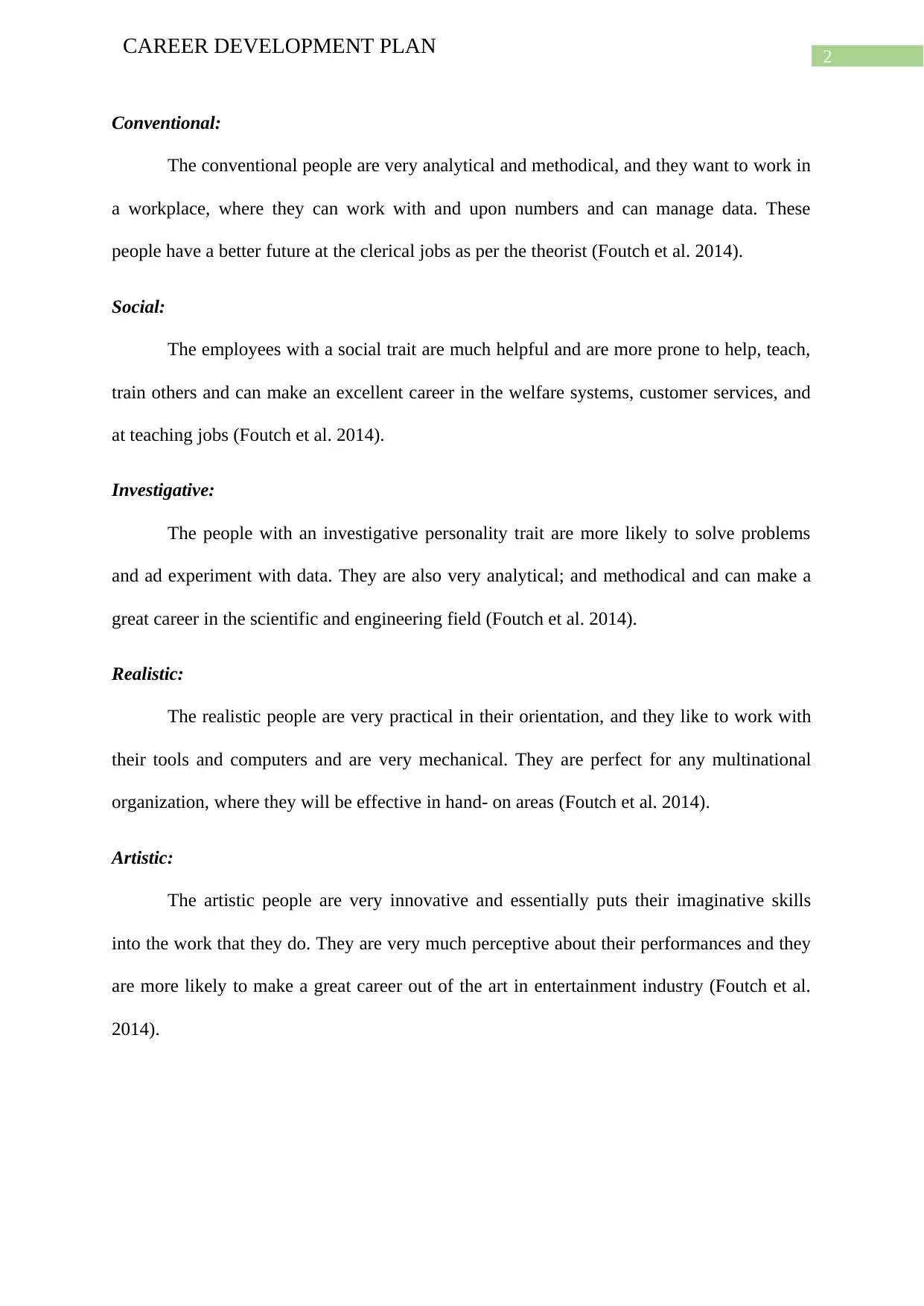
2
CAREER DEVELOPMENT PLAN
Conventional:
The conventional people are very analytical and methodical, and they want to work in
a workplace, where they can work with and upon numbers and can manage data. These
people have a better future at the clerical jobs as per the theorist (Foutch et al. 2014).
Social:
The employees with a social trait are much helpful and are more prone to help, teach,
train others and can make an excellent career in the welfare systems, customer services, and
at teaching jobs (Foutch et al. 2014).
Investigative:
The people with an investigative personality trait are more likely to solve problems
and ad experiment with data. They are also very analytical; and methodical and can make a
great career in the scientific and engineering field (Foutch et al. 2014).
Realistic:
The realistic people are very practical in their orientation, and they like to work with
their tools and computers and are very mechanical. They are perfect for any multinational
organization, where they will be effective in hand- on areas (Foutch et al. 2014).
Artistic:
The artistic people are very innovative and essentially puts their imaginative skills
into the work that they do. They are very much perceptive about their performances and they
are more likely to make a great career out of the art in entertainment industry (Foutch et al.
2014).
CAREER DEVELOPMENT PLAN
Conventional:
The conventional people are very analytical and methodical, and they want to work in
a workplace, where they can work with and upon numbers and can manage data. These
people have a better future at the clerical jobs as per the theorist (Foutch et al. 2014).
Social:
The employees with a social trait are much helpful and are more prone to help, teach,
train others and can make an excellent career in the welfare systems, customer services, and
at teaching jobs (Foutch et al. 2014).
Investigative:
The people with an investigative personality trait are more likely to solve problems
and ad experiment with data. They are also very analytical; and methodical and can make a
great career in the scientific and engineering field (Foutch et al. 2014).
Realistic:
The realistic people are very practical in their orientation, and they like to work with
their tools and computers and are very mechanical. They are perfect for any multinational
organization, where they will be effective in hand- on areas (Foutch et al. 2014).
Artistic:
The artistic people are very innovative and essentially puts their imaginative skills
into the work that they do. They are very much perceptive about their performances and they
are more likely to make a great career out of the art in entertainment industry (Foutch et al.
2014).
⊘ This is a preview!⊘
Do you want full access?
Subscribe today to unlock all pages.

Trusted by 1+ million students worldwide
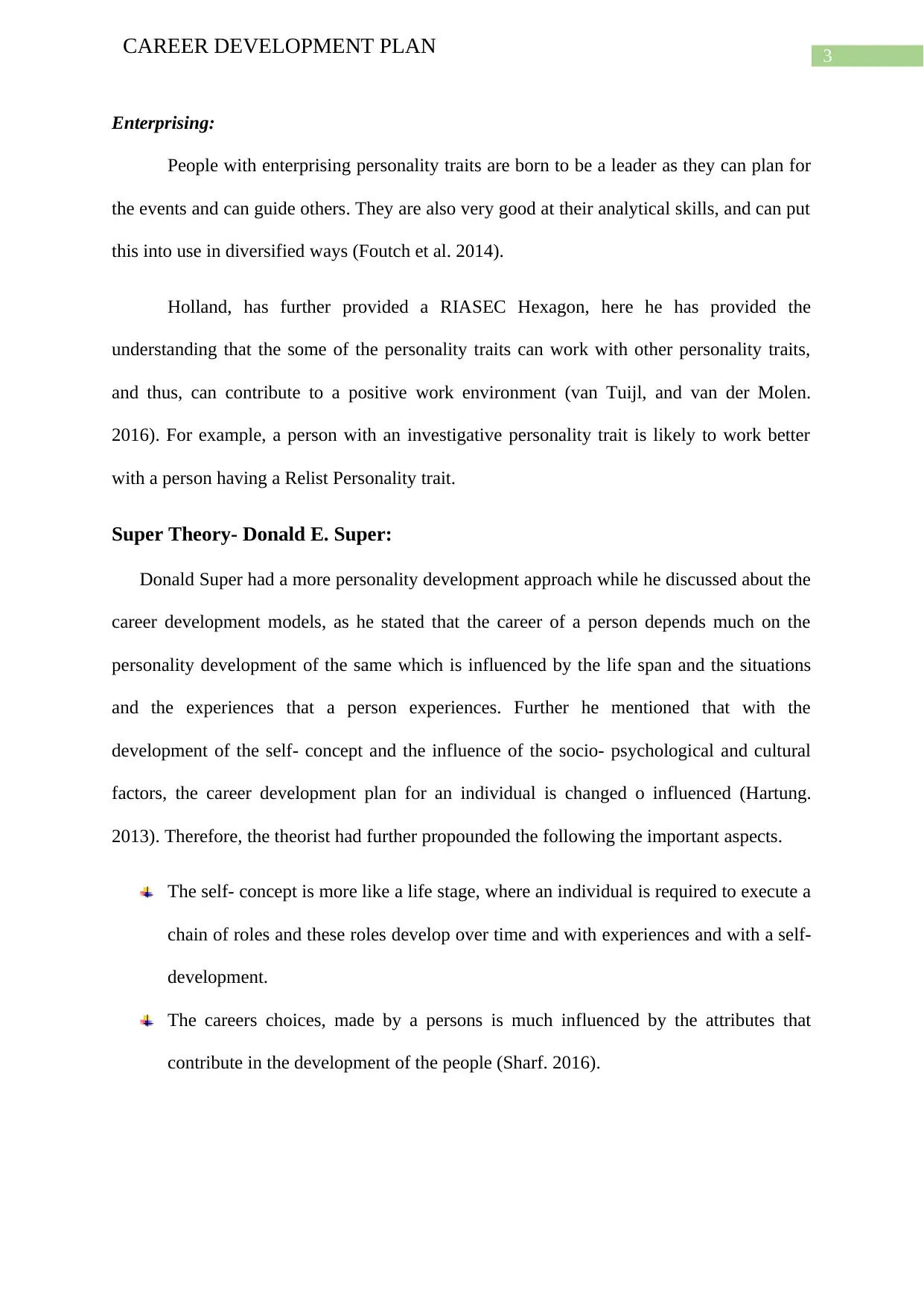
3
CAREER DEVELOPMENT PLAN
Enterprising:
People with enterprising personality traits are born to be a leader as they can plan for
the events and can guide others. They are also very good at their analytical skills, and can put
this into use in diversified ways (Foutch et al. 2014).
Holland, has further provided a RIASEC Hexagon, here he has provided the
understanding that the some of the personality traits can work with other personality traits,
and thus, can contribute to a positive work environment (van Tuijl, and van der Molen.
2016). For example, a person with an investigative personality trait is likely to work better
with a person having a Relist Personality trait.
Super Theory- Donald E. Super:
Donald Super had a more personality development approach while he discussed about the
career development models, as he stated that the career of a person depends much on the
personality development of the same which is influenced by the life span and the situations
and the experiences that a person experiences. Further he mentioned that with the
development of the self- concept and the influence of the socio- psychological and cultural
factors, the career development plan for an individual is changed o influenced (Hartung.
2013). Therefore, the theorist had further propounded the following the important aspects.
The self- concept is more like a life stage, where an individual is required to execute a
chain of roles and these roles develop over time and with experiences and with a self-
development.
The careers choices, made by a persons is much influenced by the attributes that
contribute in the development of the people (Sharf. 2016).
CAREER DEVELOPMENT PLAN
Enterprising:
People with enterprising personality traits are born to be a leader as they can plan for
the events and can guide others. They are also very good at their analytical skills, and can put
this into use in diversified ways (Foutch et al. 2014).
Holland, has further provided a RIASEC Hexagon, here he has provided the
understanding that the some of the personality traits can work with other personality traits,
and thus, can contribute to a positive work environment (van Tuijl, and van der Molen.
2016). For example, a person with an investigative personality trait is likely to work better
with a person having a Relist Personality trait.
Super Theory- Donald E. Super:
Donald Super had a more personality development approach while he discussed about the
career development models, as he stated that the career of a person depends much on the
personality development of the same which is influenced by the life span and the situations
and the experiences that a person experiences. Further he mentioned that with the
development of the self- concept and the influence of the socio- psychological and cultural
factors, the career development plan for an individual is changed o influenced (Hartung.
2013). Therefore, the theorist had further propounded the following the important aspects.
The self- concept is more like a life stage, where an individual is required to execute a
chain of roles and these roles develop over time and with experiences and with a self-
development.
The careers choices, made by a persons is much influenced by the attributes that
contribute in the development of the people (Sharf. 2016).
Paraphrase This Document
Need a fresh take? Get an instant paraphrase of this document with our AI Paraphraser
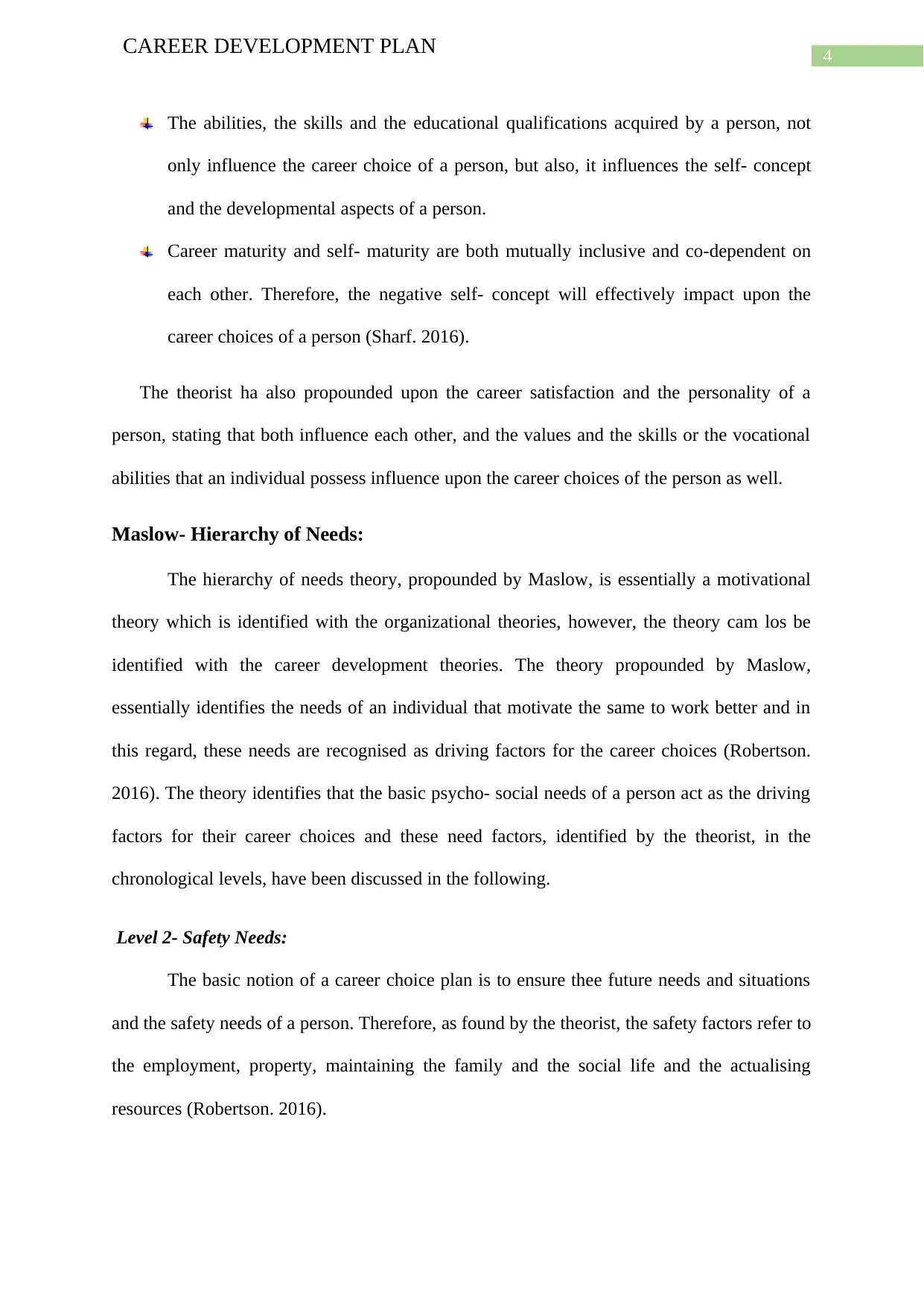
4
CAREER DEVELOPMENT PLAN
The abilities, the skills and the educational qualifications acquired by a person, not
only influence the career choice of a person, but also, it influences the self- concept
and the developmental aspects of a person.
Career maturity and self- maturity are both mutually inclusive and co-dependent on
each other. Therefore, the negative self- concept will effectively impact upon the
career choices of a person (Sharf. 2016).
The theorist ha also propounded upon the career satisfaction and the personality of a
person, stating that both influence each other, and the values and the skills or the vocational
abilities that an individual possess influence upon the career choices of the person as well.
Maslow- Hierarchy of Needs:
The hierarchy of needs theory, propounded by Maslow, is essentially a motivational
theory which is identified with the organizational theories, however, the theory cam los be
identified with the career development theories. The theory propounded by Maslow,
essentially identifies the needs of an individual that motivate the same to work better and in
this regard, these needs are recognised as driving factors for the career choices (Robertson.
2016). The theory identifies that the basic psycho- social needs of a person act as the driving
factors for their career choices and these need factors, identified by the theorist, in the
chronological levels, have been discussed in the following.
Level 2- Safety Needs:
The basic notion of a career choice plan is to ensure thee future needs and situations
and the safety needs of a person. Therefore, as found by the theorist, the safety factors refer to
the employment, property, maintaining the family and the social life and the actualising
resources (Robertson. 2016).
CAREER DEVELOPMENT PLAN
The abilities, the skills and the educational qualifications acquired by a person, not
only influence the career choice of a person, but also, it influences the self- concept
and the developmental aspects of a person.
Career maturity and self- maturity are both mutually inclusive and co-dependent on
each other. Therefore, the negative self- concept will effectively impact upon the
career choices of a person (Sharf. 2016).
The theorist ha also propounded upon the career satisfaction and the personality of a
person, stating that both influence each other, and the values and the skills or the vocational
abilities that an individual possess influence upon the career choices of the person as well.
Maslow- Hierarchy of Needs:
The hierarchy of needs theory, propounded by Maslow, is essentially a motivational
theory which is identified with the organizational theories, however, the theory cam los be
identified with the career development theories. The theory propounded by Maslow,
essentially identifies the needs of an individual that motivate the same to work better and in
this regard, these needs are recognised as driving factors for the career choices (Robertson.
2016). The theory identifies that the basic psycho- social needs of a person act as the driving
factors for their career choices and these need factors, identified by the theorist, in the
chronological levels, have been discussed in the following.
Level 2- Safety Needs:
The basic notion of a career choice plan is to ensure thee future needs and situations
and the safety needs of a person. Therefore, as found by the theorist, the safety factors refer to
the employment, property, maintaining the family and the social life and the actualising
resources (Robertson. 2016).
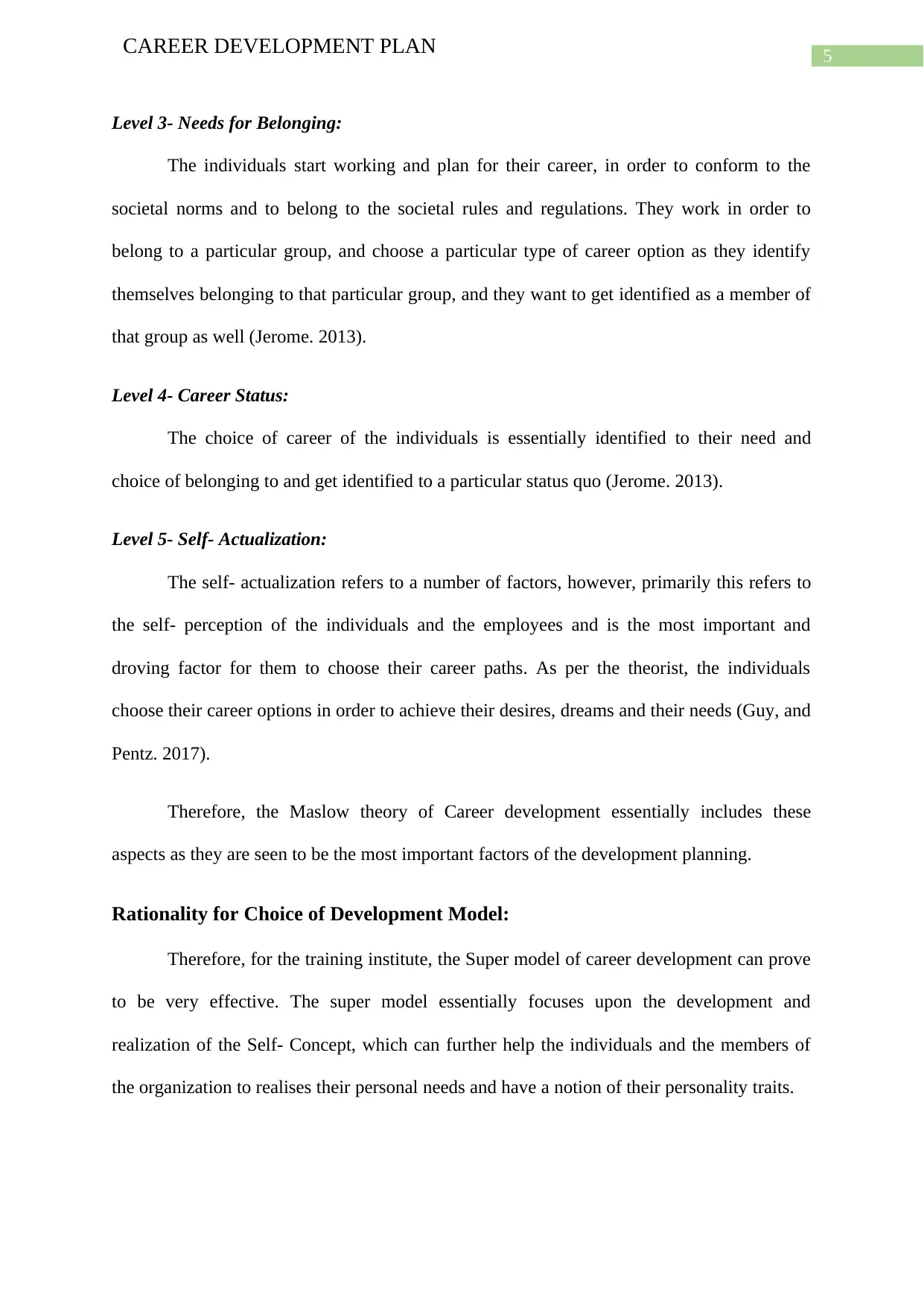
5
CAREER DEVELOPMENT PLAN
Level 3- Needs for Belonging:
The individuals start working and plan for their career, in order to conform to the
societal norms and to belong to the societal rules and regulations. They work in order to
belong to a particular group, and choose a particular type of career option as they identify
themselves belonging to that particular group, and they want to get identified as a member of
that group as well (Jerome. 2013).
Level 4- Career Status:
The choice of career of the individuals is essentially identified to their need and
choice of belonging to and get identified to a particular status quo (Jerome. 2013).
Level 5- Self- Actualization:
The self- actualization refers to a number of factors, however, primarily this refers to
the self- perception of the individuals and the employees and is the most important and
droving factor for them to choose their career paths. As per the theorist, the individuals
choose their career options in order to achieve their desires, dreams and their needs (Guy, and
Pentz. 2017).
Therefore, the Maslow theory of Career development essentially includes these
aspects as they are seen to be the most important factors of the development planning.
Rationality for Choice of Development Model:
Therefore, for the training institute, the Super model of career development can prove
to be very effective. The super model essentially focuses upon the development and
realization of the Self- Concept, which can further help the individuals and the members of
the organization to realises their personal needs and have a notion of their personality traits.
CAREER DEVELOPMENT PLAN
Level 3- Needs for Belonging:
The individuals start working and plan for their career, in order to conform to the
societal norms and to belong to the societal rules and regulations. They work in order to
belong to a particular group, and choose a particular type of career option as they identify
themselves belonging to that particular group, and they want to get identified as a member of
that group as well (Jerome. 2013).
Level 4- Career Status:
The choice of career of the individuals is essentially identified to their need and
choice of belonging to and get identified to a particular status quo (Jerome. 2013).
Level 5- Self- Actualization:
The self- actualization refers to a number of factors, however, primarily this refers to
the self- perception of the individuals and the employees and is the most important and
droving factor for them to choose their career paths. As per the theorist, the individuals
choose their career options in order to achieve their desires, dreams and their needs (Guy, and
Pentz. 2017).
Therefore, the Maslow theory of Career development essentially includes these
aspects as they are seen to be the most important factors of the development planning.
Rationality for Choice of Development Model:
Therefore, for the training institute, the Super model of career development can prove
to be very effective. The super model essentially focuses upon the development and
realization of the Self- Concept, which can further help the individuals and the members of
the organization to realises their personal needs and have a notion of their personality traits.
⊘ This is a preview!⊘
Do you want full access?
Subscribe today to unlock all pages.

Trusted by 1+ million students worldwide
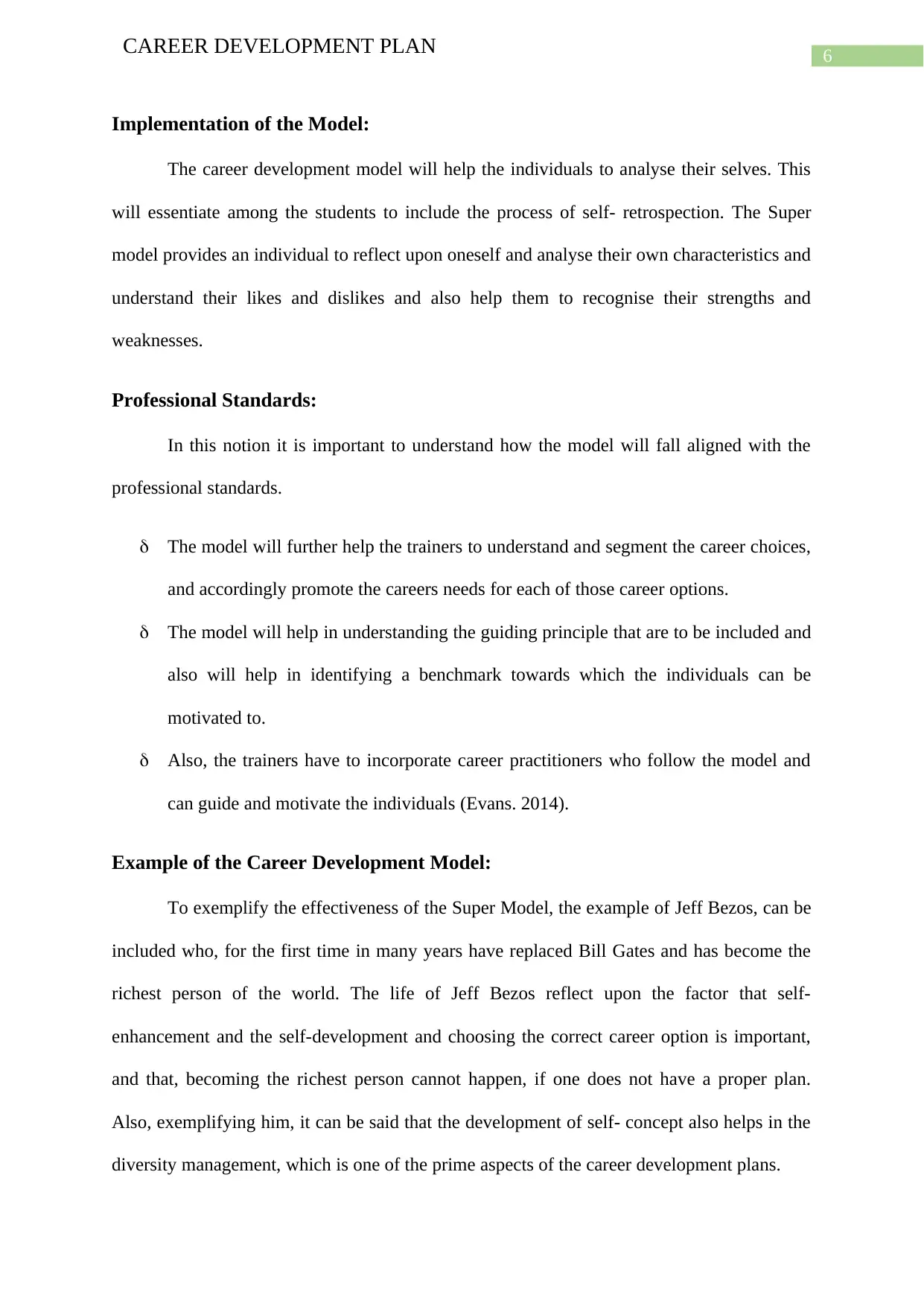
6
CAREER DEVELOPMENT PLAN
Implementation of the Model:
The career development model will help the individuals to analyse their selves. This
will essentiate among the students to include the process of self- retrospection. The Super
model provides an individual to reflect upon oneself and analyse their own characteristics and
understand their likes and dislikes and also help them to recognise their strengths and
weaknesses.
Professional Standards:
In this notion it is important to understand how the model will fall aligned with the
professional standards.
The model will further help the trainers to understand and segment the career choices,
and accordingly promote the careers needs for each of those career options.
The model will help in understanding the guiding principle that are to be included and
also will help in identifying a benchmark towards which the individuals can be
motivated to.
Also, the trainers have to incorporate career practitioners who follow the model and
can guide and motivate the individuals (Evans. 2014).
Example of the Career Development Model:
To exemplify the effectiveness of the Super Model, the example of Jeff Bezos, can be
included who, for the first time in many years have replaced Bill Gates and has become the
richest person of the world. The life of Jeff Bezos reflect upon the factor that self-
enhancement and the self-development and choosing the correct career option is important,
and that, becoming the richest person cannot happen, if one does not have a proper plan.
Also, exemplifying him, it can be said that the development of self- concept also helps in the
diversity management, which is one of the prime aspects of the career development plans.
CAREER DEVELOPMENT PLAN
Implementation of the Model:
The career development model will help the individuals to analyse their selves. This
will essentiate among the students to include the process of self- retrospection. The Super
model provides an individual to reflect upon oneself and analyse their own characteristics and
understand their likes and dislikes and also help them to recognise their strengths and
weaknesses.
Professional Standards:
In this notion it is important to understand how the model will fall aligned with the
professional standards.
The model will further help the trainers to understand and segment the career choices,
and accordingly promote the careers needs for each of those career options.
The model will help in understanding the guiding principle that are to be included and
also will help in identifying a benchmark towards which the individuals can be
motivated to.
Also, the trainers have to incorporate career practitioners who follow the model and
can guide and motivate the individuals (Evans. 2014).
Example of the Career Development Model:
To exemplify the effectiveness of the Super Model, the example of Jeff Bezos, can be
included who, for the first time in many years have replaced Bill Gates and has become the
richest person of the world. The life of Jeff Bezos reflect upon the factor that self-
enhancement and the self-development and choosing the correct career option is important,
and that, becoming the richest person cannot happen, if one does not have a proper plan.
Also, exemplifying him, it can be said that the development of self- concept also helps in the
diversity management, which is one of the prime aspects of the career development plans.
Paraphrase This Document
Need a fresh take? Get an instant paraphrase of this document with our AI Paraphraser
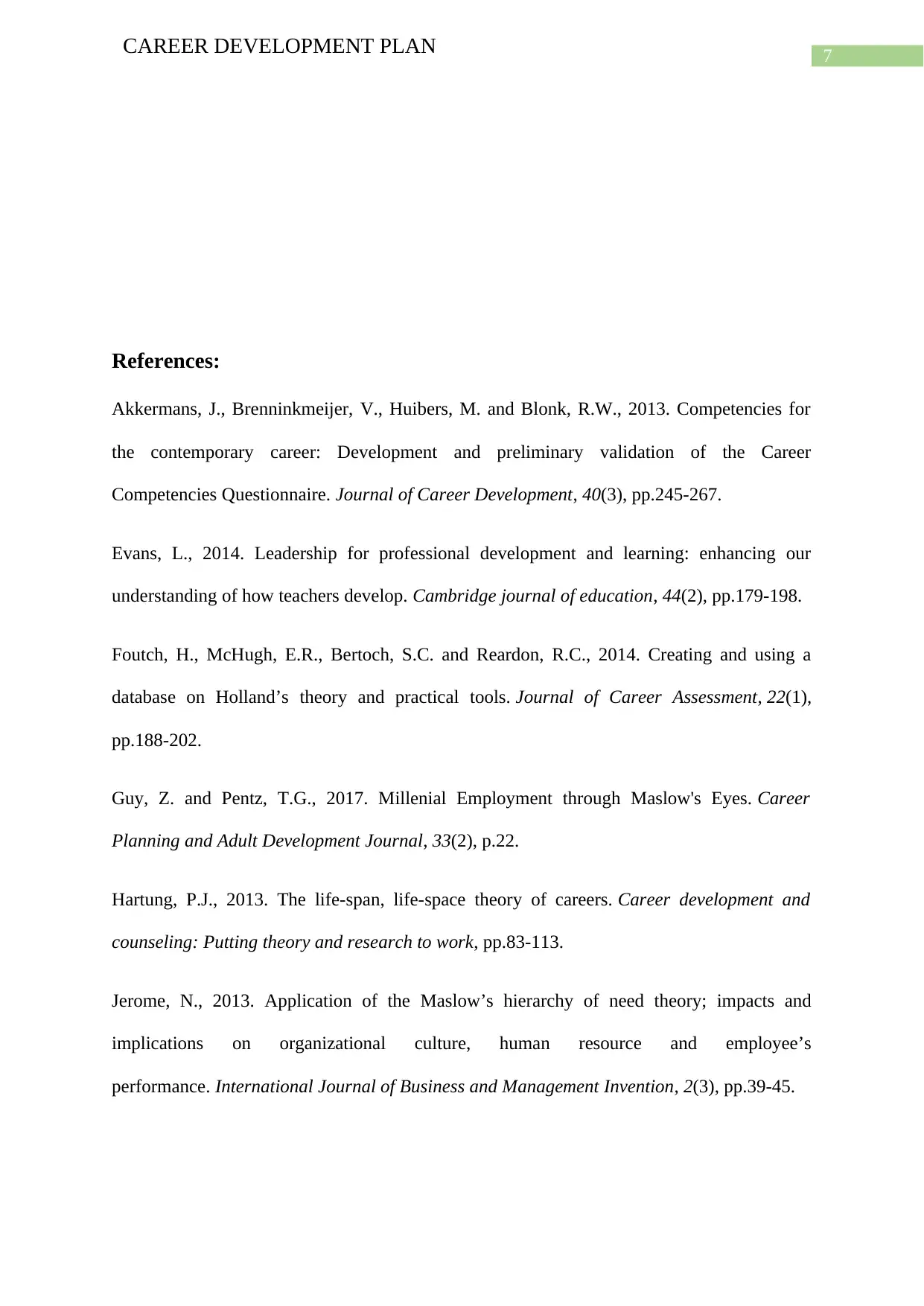
7
CAREER DEVELOPMENT PLAN
References:
Akkermans, J., Brenninkmeijer, V., Huibers, M. and Blonk, R.W., 2013. Competencies for
the contemporary career: Development and preliminary validation of the Career
Competencies Questionnaire. Journal of Career Development, 40(3), pp.245-267.
Evans, L., 2014. Leadership for professional development and learning: enhancing our
understanding of how teachers develop. Cambridge journal of education, 44(2), pp.179-198.
Foutch, H., McHugh, E.R., Bertoch, S.C. and Reardon, R.C., 2014. Creating and using a
database on Holland’s theory and practical tools. Journal of Career Assessment, 22(1),
pp.188-202.
Guy, Z. and Pentz, T.G., 2017. Millenial Employment through Maslow's Eyes. Career
Planning and Adult Development Journal, 33(2), p.22.
Hartung, P.J., 2013. The life-span, life-space theory of careers. Career development and
counseling: Putting theory and research to work, pp.83-113.
Jerome, N., 2013. Application of the Maslow’s hierarchy of need theory; impacts and
implications on organizational culture, human resource and employee’s
performance. International Journal of Business and Management Invention, 2(3), pp.39-45.
CAREER DEVELOPMENT PLAN
References:
Akkermans, J., Brenninkmeijer, V., Huibers, M. and Blonk, R.W., 2013. Competencies for
the contemporary career: Development and preliminary validation of the Career
Competencies Questionnaire. Journal of Career Development, 40(3), pp.245-267.
Evans, L., 2014. Leadership for professional development and learning: enhancing our
understanding of how teachers develop. Cambridge journal of education, 44(2), pp.179-198.
Foutch, H., McHugh, E.R., Bertoch, S.C. and Reardon, R.C., 2014. Creating and using a
database on Holland’s theory and practical tools. Journal of Career Assessment, 22(1),
pp.188-202.
Guy, Z. and Pentz, T.G., 2017. Millenial Employment through Maslow's Eyes. Career
Planning and Adult Development Journal, 33(2), p.22.
Hartung, P.J., 2013. The life-span, life-space theory of careers. Career development and
counseling: Putting theory and research to work, pp.83-113.
Jerome, N., 2013. Application of the Maslow’s hierarchy of need theory; impacts and
implications on organizational culture, human resource and employee’s
performance. International Journal of Business and Management Invention, 2(3), pp.39-45.
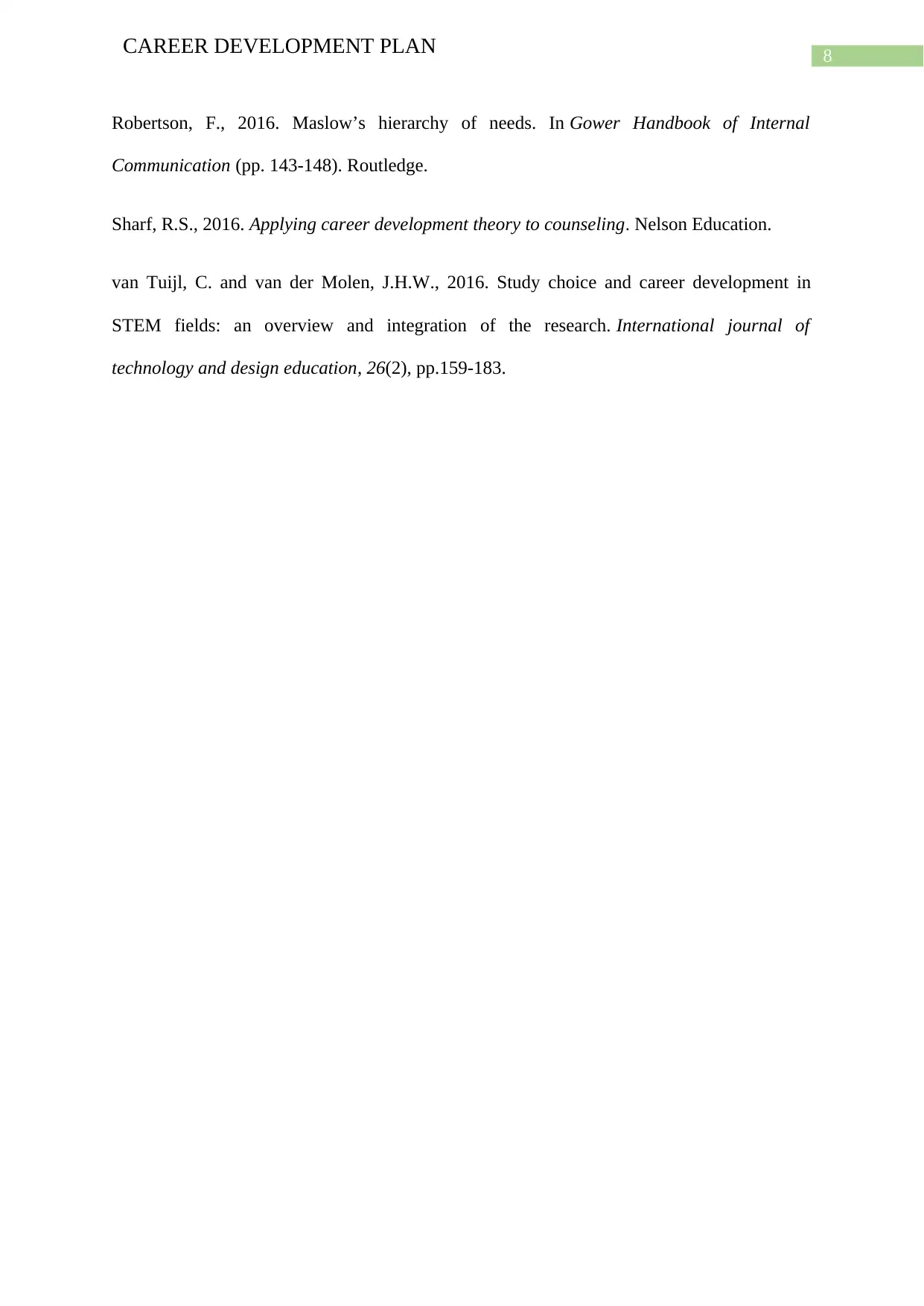
8
CAREER DEVELOPMENT PLAN
Robertson, F., 2016. Maslow’s hierarchy of needs. In Gower Handbook of Internal
Communication (pp. 143-148). Routledge.
Sharf, R.S., 2016. Applying career development theory to counseling. Nelson Education.
van Tuijl, C. and van der Molen, J.H.W., 2016. Study choice and career development in
STEM fields: an overview and integration of the research. International journal of
technology and design education, 26(2), pp.159-183.
CAREER DEVELOPMENT PLAN
Robertson, F., 2016. Maslow’s hierarchy of needs. In Gower Handbook of Internal
Communication (pp. 143-148). Routledge.
Sharf, R.S., 2016. Applying career development theory to counseling. Nelson Education.
van Tuijl, C. and van der Molen, J.H.W., 2016. Study choice and career development in
STEM fields: an overview and integration of the research. International journal of
technology and design education, 26(2), pp.159-183.
⊘ This is a preview!⊘
Do you want full access?
Subscribe today to unlock all pages.

Trusted by 1+ million students worldwide
1 out of 9
Related Documents
Your All-in-One AI-Powered Toolkit for Academic Success.
+13062052269
info@desklib.com
Available 24*7 on WhatsApp / Email
![[object Object]](/_next/static/media/star-bottom.7253800d.svg)
Unlock your academic potential
Copyright © 2020–2025 A2Z Services. All Rights Reserved. Developed and managed by ZUCOL.





